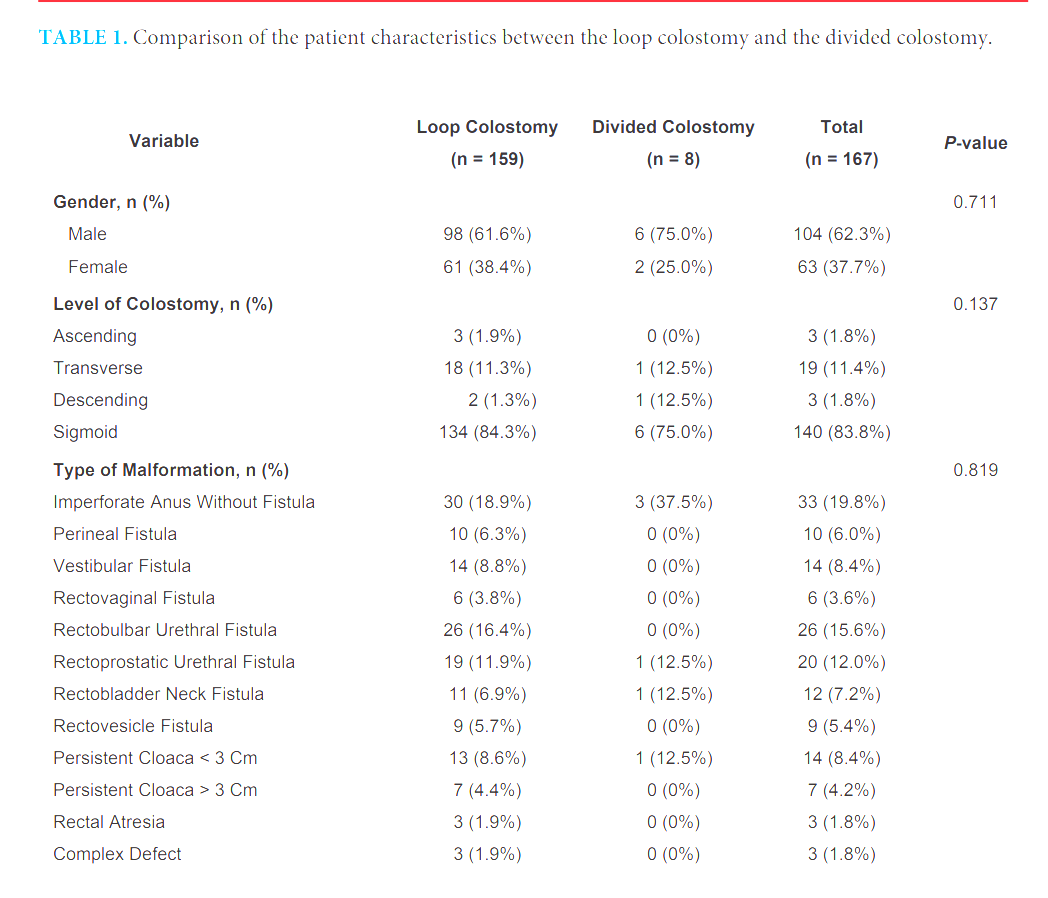Types and Levels of Colostomy in Children with Anorectal Malformation
DOI:
https://doi.org/10.33192/Smj.2022.81Keywords:
Anorectal malformation, Loop colostomy, Divided colostomy, Colostomy prolapse, urinal tract infectionAbstract
Objective: Divided colostomy for anorectal management is often recommended due to reports of higher complications associated with loop colostomy. This study was conducted to compare outcomes and complications in colostomies in children with anorectal malformations according to type and level of colostomy.
Materials and Methods: A retrospective study was performed in children with anorectal malformations who underwent a colostomy at Siriraj Hospital between December 2003 and June 2018.
Results: Out of 167 patients, 159 had a loop colostomy while 8 had a divided colostomy. Overall complication rates were 33.3% for loop colostomy and 62.5% for divided colostomy (p = 0.100). Urinary tract infection was the most frequently encountered complication in both loop and divided colostomies, at 23.7% and 50%, respectively (p = 0.094). The prolapse rate in the loop colostomy group was 8.8 % and 0% in the divided colostomy group (p = 0.376). Overall complication rates with respect to location of stoma also did not differ (p = 0.706). Prolapse rates were 15.8 % in transverse colostomy and 7.1 % in sigmoid colostomy (p = 0.231). Overall complications rates of colostomy closure in loop and divided colostomy was 7.5% and 12.5%, respectively (p = 0.672). Non-inferiority was demonstrated by the differences in overall complications of loop and divided colostomy (p = 0.008).
Conclusion: There was no difference in incidence of complications between type or location of colostomy performed in children with anorectal malformations. Loop colostomy was non-inferior to divided colostomy in respect to overall complications.
References
Sahoo S, Ganguly R, Dash M, Pradhan A, Priya TG, Mohanty. Study of Congenital Malformation in a Tertiary Care Teaching Hospital. Siriraj Med J. 2021;73(9):609-13.
Pena A, Migotto-Krieger M, Levitt MA. Colostomy in anorectal malformations: a procedure with serious but preventable complications. J Pediatr Surg. 2006;41(4):748-56.
Oda O, Davies D, Colapinto K, Gerstle JT. Loop versus divided colostomy for the management of anorectal malformations. J Pediatr Surg. 2014;49(1):87-90.
Levitt MA, Peña A. Imperforate anus and cloacal malformations. In: Holcomb III GW, Murphy JA, ed. Ashcraft’s Pediatric Surgery, 5th edition, Philadelphia: Saunders Elsevier; 2010.p.468-90.
Wilkins S, Peña A. The role of colostomy in the management of anorectal malformations. Pediatr Surg Int. 1988;3:105-9.
Gardikis S, Antypas S, Mamoulakis C, Demetriades D, Dolatzas T,Tsalkidis A, et al. Colostomy type in anorectal malformations: 10-years experience. Minerva Pediatr 2004; 56(4):425-9.
Liechty ST, Barnhart DC, Huber JT, Zobell S, Rollins MD. The morbidity of a divided stoma compared to a loop colostomy in patients with anorectal malformation. J Pediatr Surg. 2016;51(1):107-10
Patwardhan N, Kiely EM, Drake DP, Spitz L, Pierro A. Colostomy for anorectal anomalies: high incidence of complications. J Pediatr Surg. 2001;36(5):795-8.
van den Hondel D, Sloots C, Meeussen C, Wijnen R. To split ornot to split: colostomy complications for anorectal malformations
or hirschsprung disease: a single center experience and a systematic review of the literature. Eur J Pediatr Surg. 2014;24(1):61-9.
Demirogullari B, Yilmaz Y, Yildiz GE, Ozen IO, Karabulut R, Turkyilmaz Z, et al. Ostomy complications in patients with anorectal malformations. Pediatr Surg Int. 2011;27(10):1075-8.
Almosallam OI, Aseeri A, Shanafey SA. Outcome of loop versus divided colostomy in the management

Published
How to Cite
Issue
Section
License

This work is licensed under a Creative Commons Attribution-NonCommercial-NoDerivatives 4.0 International License.
Authors who publish with this journal agree to the following conditions:
Copyright Transfer
In submitting a manuscript, the authors acknowledge that the work will become the copyrighted property of Siriraj Medical Journal upon publication.
License
Articles are licensed under a Creative Commons Attribution-NonCommercial-NoDerivatives 4.0 International License (CC BY-NC-ND 4.0). This license allows for the sharing of the work for non-commercial purposes with proper attribution to the authors and the journal. However, it does not permit modifications or the creation of derivative works.
Sharing and Access
Authors are encouraged to share their article on their personal or institutional websites and through other non-commercial platforms. Doing so can increase readership and citations.













